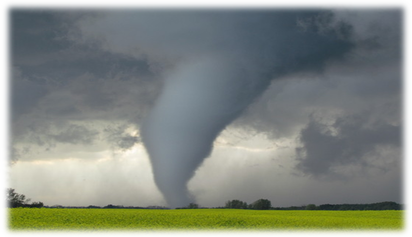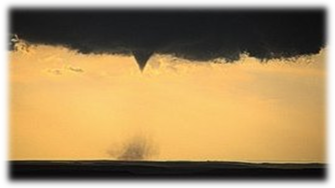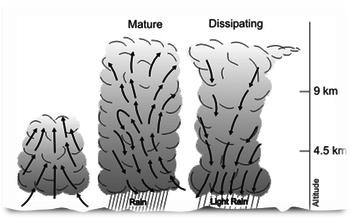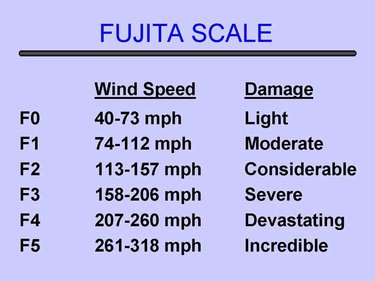
We are all aware of the natural disasters that occur either on land, or in water, or both. However, all of these disasters have a great impact on life, livestock and property. However, one disaster is such that it extends from the sky down to the ground. One can imagine how devastating it can be! It not only brings along the tropical storms but also sometimes accompanies Hurricanes. It is a Tornado. Tornadoes are formed from severe thunderstorms and are often referred to as ‘twisters’. The winds of the Tornado may exceed about 300 miles an hour and hence it can lift cars, mobile homes and animals into the air. They usually occur when a warm front meet a cold front, forming one or more twisters. In simple words, a Tornado is a funnel-shaped rotating cloud which extends from the whirling winds to the ground. Tornadoes are usually transparent but they become funnel due to the dust and debris that are picked up along with the wind. Let us understand the detailed aspects of Tornadoes.
Tornado is derived from the Latin word meaning ‘to thunder’. However, the Spanish modified the word and developed it to ‘tornear’ meaning ‘to turn or twist’. This is one of the reasons why they are called twisters. The powerful column of winds that spiral around the centre of low atmospheric pressure is a Tornado. Tornadoes rotate counter clockwise in the Northern Hemisphere and move eastwards and rotate clockwise in the Southern Hemisphere. A Tornado may last for few seconds to few hours. It may travel with high speed to the ground and then suddenly vanish.

A visible condensation funnel appears from the base of the storm as the area of organized rotation

approaches the ground. The winds inside the Tornado whirl upwards with immense speed and power. The fierce winds are then capable to tear apart and create an internal vacuum when the funnel touches a structure. Generally, the winds of Tornado can spin approximately 500 miles per hour, but it is usually recorded at roughly 300 miles an hour.
In advance of eastward-moving cold fronts, thunderstorms are developed in warm and moist air. Hence, large outbreaks of Tornadoes occur with this type of weather. These thunderstorms frequently develop along a dry line during spring in the Central Plains that separate the warm and moist air to the east from the hot and dry air to the west. Occasionally, tropical storms and Hurricanes are accompanied by Tornadoes that move over land. However, there may be two Tornadoes that may occur at the same time.
The descending cold air moves toward the outside of the thunder cell as the warm air moves up to the centre of the Tornado and also eventually wraps around the rotating system and cuts the inflow of warm air which feeds the Tornado. Due to the restricted inflow of the warm air, the cold air chokes the Tornado’s air supply completely. This weakens the Tornadoes and it becomes thin like a rope. At this dissipating stage, the Tornado dissolves within minutes.

The F-Scale, also commonly called as the Fujita Scale, classifies the intensity of the Tornadoes based on the resulting damage. It was developed by Dr. T. Theodore in 1971. He has rated the types of damage as:
-
Minimal Damage (F0): When the speed of the wind is 64 to 116 km/h, it is a Minimal Damage. It may result in damage to chimneys, TV antennas, roof shingles, trees and windows. Moderate
-
Damage (F1): When the speed of the wind is about 117 to 180 km/h, it is a Moderate Damage. It may result in automobiles overturned, carports destroyed and trees uprooted.
-
Major Damage (F2): When the wind’s speed is about 181 to 253 km/h, it may lead to Major Damage. One can see roofs blown off the homes, sheds and outbuildings demolished and mobile homes overturned.
-
Severe Damage (F3): It is a Severe Damage when the speed of the wind is about 254 to 332 km/h. It may lead to exterior walls and roofs blown off the homes, metal buildings collapsed or severely damaged and flattened forest and farmland.
-
Devastating Damage (F4): When the speed of the wind is about 333 to 418 km/h, it is a Devastating Damage. It results in demolishing of few walls in well-built homes and buildings and large steel and concrete missiles are thrown at far distances.
-
Incredible Damage (F5): It may cause an Incredible Damage when the force of the wind is between 419 to 512 km/h and its effects may result in homes levelled with all debris being removed, schools and other structures being considerably damaged and demolished.

Tornadoes usually occur in areas mentioned below:
-
The United States
-
Canada
-
Europe
-
Birmingham
-
United Kingdom
-
Bangladesh and India
-
South America
-
Africa
-
Australia
G Kowledge of | 0 Comments >>
0 Comments
Leave Comment
Your email address will not be published. Required fields are marked.